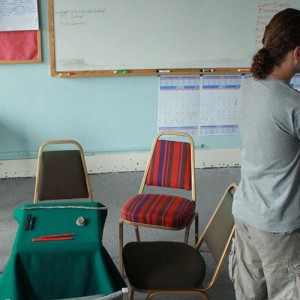As prompted by Stefan, a WAYK player from Germany, Evan Gardner and Willem Larsen discuss choosing the ideal signed language for using as a bridge language, in relation to your target spoken language.
1. Technique: “Bridge Language“
- Stefan asks: which is more effective, using the WAYK ASL/Pidgin Signed English (PSE), or a local signed language?
- Total Physical Response: why we use signed languages as bridge languages.
- Signed languages are endangered too.
- ASL/PSE carries a bit of American culture and language.
- Learn WAYK with PSE signs first, then find a local (or target culture) Deafie and change WAYK to fit their signed language.
2. Technique “Most Likely to Succeed“
- You are living in the ideal situation for whatever resources you actually have.
3. Technique “Baby Steps“
- Evan has another idea for someone’s Ph.D. study.
- Ideal scenario: come to our next two day workshop in San Francisco, then invite us back to your home community for a local workshop to train your community, and invite WAYK players from other areas to come help out as “lunatic fringe“.
- The pros and cons of a ‘universal language’.
- WAYK is a seed, a beginning.
4. Technique “Limit“
5. Technique “Language Hunters“
- Do you train “language hunters“, or just transfer fluent proficiency in the target language?
6. Technique “UNIVERSAL SPEED CURRICULUM“
- ‘Universal’ means a universal starting point.
- Dustin Rivers, a Squamish WAYK instructor, has begun translating technique names into Squamish language.
- Will English always be the ‘official’ language of WAYK techniques?
- Please: make us as silly and obsolete as Albert Einstein. Pretty please?
- Evan and Willem are limited by their own imagination. Of course!
- They both expect new players, once they master the game, to take it beyond a horizon they can see.
- Send us video!






[…] [direct download here] […]
Great! I was asking myself all of this ^^. I live in Belgium and speak French as my primary language, and here we have 6 different sign-languages for French, and none of them is bigger or more used than the other ones. I’ll ask around to see if I can find someone who speaks any kind of sign-language, and if I don’t find any, I’ll just use the one used in the tutorial.
Another thing I’d have to do before starting playing WAYK here is translating the techniques names to catchy French names. Because that’s also an issue: while “Copycat” can be something fairly common in English, the closest to that in French is « Copieur » witch means “The one who copies”. But that isn’t really catchy 🙁 In copycat, you have cat. Cats are fun, and you learn the sign by remembering the “cat” sign.
In kindergarten, kids say «Copieur!» to other kids when they copy what they’re doing: if a kid is drawing a blue house, and another kid looks at his drawing and start making a blue house himself, the first will shout « COPIEUR! » to the second one. That gives to «Copieur» a negative feeling that we don’t want in WAYK. :S
Alexandre,
6 different sign languages for French?! WOW!
Translating techniques into your particular bridge language is definitely an art, not a science. I’m going to try and give you some advice, but only you know whether it’ll work for your language, culture, etc.
“Copycat” actually has the same connotation here in the USA, as “copieur!”. We’re able to “cute”-ify it somewhat by making a kitty hand sign, but essentially, we’re purposely creating a paradox by using a sign that usually means something somewhat negative, and encouraging people to do it!
For the same reason, I wouldn’t hesitate from using a word like “cheat” either. Anything that is funny, oddball, and alerts folks that “this is a game, this is not learning as usual!”.
We always know we’ve chosen a good technique name if it makes people laugh. Not all the technique names do this, but it’s definitely our goal.
Good luck – keep us posted on your game play, and if possible, send video, and we’ll happily watch it and give you pointers.